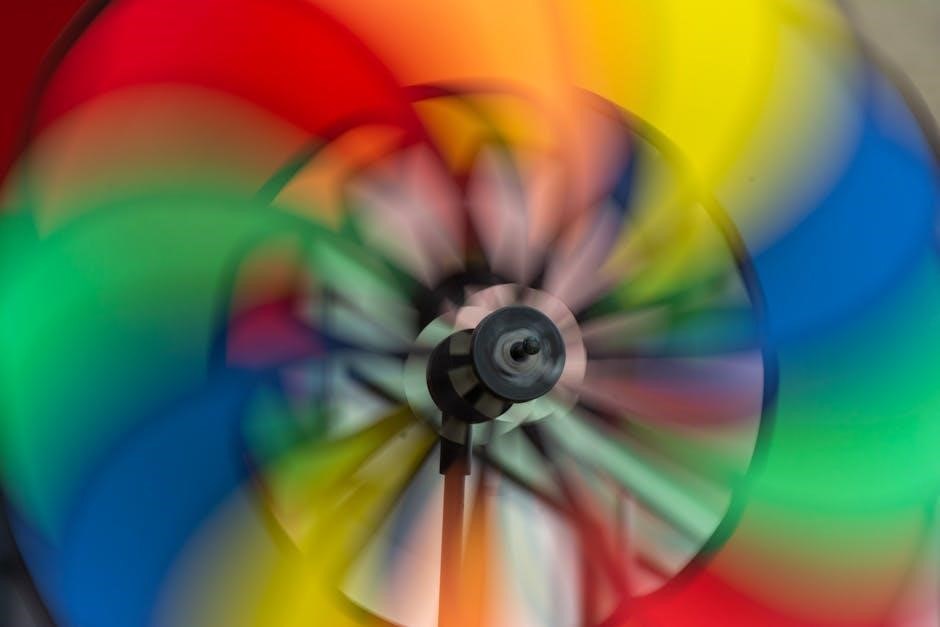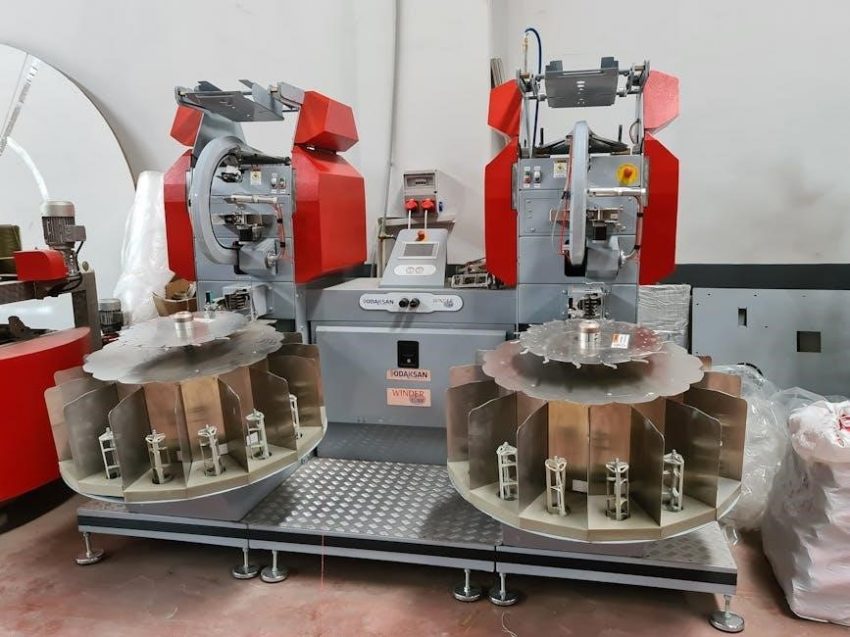Assembling a wind spinner is a fun and rewarding DIY project, offering a creative way to enhance your garden while teaching basic engineering principles and providing a beautiful kinetic display․
What is a Wind Spinner?
A wind spinner is a decorative outdoor item designed to rotate gracefully in the breeze, adding visual interest to gardens or yards․ Typically made of durable materials like metal or copper, these kinetic sculptures come in various shapes, from simple blades to intricate designs․ They harness wind energy to create a mesmerizing spinning motion, offering both aesthetic appeal and a soothing, meditative effect․ Wind spinners are popular for their low maintenance and ability to enhance outdoor spaces with dynamic beauty․
Why Assemble a Wind Spinner?
Assembling a wind spinner offers a rewarding DIY experience, combining creativity with practical skills․ It provides an opportunity to customize your garden decor while learning basic engineering principles․ Building a wind spinner can be a fun family project, teaching children about wind energy and mechanics․ Additionally, it allows for personalization, ensuring the final product matches your garden’s unique style․ The process fosters a sense of accomplishment and satisfaction, transforming simple materials into a beautiful, functional kinetic sculpture that enhances your outdoor space․

Tools and Materials Needed
Essential tools include screwdrivers, wrenches, and pliers․ Materials required are metal rods, copper components, spinning blades, a base plate, and fasteners for secure assembly․

Essential Tools for Assembly
To successfully assemble a wind spinner, you will need a set of basic tools․ These include screwdrivers (both flathead and Phillips), adjustable wrenches, pliers, and a socket set for tightening bolts; Additionally, a drill may be required for pre-drilling holes in some components․ Ensure all tools are in good working condition to avoid stripped screws or bolts․ Having a workbench or sturdy surface to lay out parts is also beneficial for organization․ Proper tools ensure a smooth and efficient assembly process, minimizing frustration and ensuring all parts fit securely together․
Metal and Copper Components
Metal and copper components are integral to wind spinner construction, offering durability and aesthetic appeal․ Copper is prized for its natural beauty and resistance to corrosion, while stainless steel and aluminum provide strength and lightweight durability․ These materials are often pre-cut and shaped for easy assembly, ensuring a seamless fit․ Properly crafted metal components ensure longevity and stability, even in windy conditions, while copper accents add a decorative touch that enhances the spinner’s visual appeal․

Step-by-Step Assembly Instructions
Building a wind spinner involves unpacking, organizing parts, attaching blades, and securing components for smooth rotation․ Follow detailed steps to ensure balance and durability for lasting enjoyment․
Unpacking and Organizing Parts
Begin by carefully unpacking all components, ensuring no damage occurs during removal․ Lay out the base, shaft, spinner blades, connectors, and hardware on a clean, flat surface․ Organize parts by type and size for easy access․ Use the provided manual to identify and verify each piece, ensuring all items are included․ This step prevents delays and ensures a smooth assembly process․ Pay special attention to small hardware like screws and bolts, storing them in a safe place to avoid loss․ Proper organization is key to efficient and stress-free assembly․
Preparing the Base and Shaft

Start by assembling the base according to the manufacturer’s instructions, ensuring all bolts are securely tightened․ Attach the shaft to the base by aligning it with the designated holes or marks․ Use the provided brackets or clamps to secure the shaft tightly, ensuring it is straight and evenly balanced․ If necessary, apply a small amount of lubricant to moving parts for smooth operation․ Check the ground for softness and stability before inserting the shaft, adjusting as needed for optimal placement and visibility․ Double-check all connections to ensure stability and proper function․
Assembling the Spinner Blades
Begin by unpacking and identifying the spinner blades, ensuring they match the design specified in your instructions․ Attach each blade to the central hub or spindle using the provided screws or bolts․ Align the holes carefully for a secure fit․ Tighten firmly but avoid over-tightening, which may damage the material․ Once all blades are attached, inspect the spinner for balance and symmetry․ If necessary, adjust the blades slightly to achieve even weight distribution․ Handle the blades with care to prevent bending or scratching during assembly․ Ensure all connections are secure before moving on to the next step․
Securing the Blades to the Shaft
Attach the assembled spinner blades to the shaft using the provided screws or bolts․ Ensure the blades are evenly spaced and aligned perpendicular to the ground․ Tighten each screw securely, but avoid over-tightening, which may strip the threads․ Double-check the alignment to ensure the spinner rotates smoothly․ If your kit includes a locking mechanism, engage it to prevent the blades from shifting during operation․ Properly securing the blades ensures stability and optimal performance of your wind spinner․ Always refer to the manufacturer’s instructions for specific hardware requirements․
Final Assembly and Balance Check
Once all components are assembled, attach the spinner head to the shaft and base․ Ensure all connections are secure and tightly fastened․ Perform a balance check by gently spinning the blades to confirm smooth rotation․ If imbalance occurs, adjust the blade positions or weights․ Test the spinner in a breezy area to ensure proper movement․ Finally, tighten all connections and apply any decorative accents․ A balanced assembly ensures optimal performance and longevity of your wind spinner․ Follow the manufacturer’s guidelines for final adjustments․
Care and Maintenance Tips
Regularly clean your wind spinner to remove dirt and debris․ Lubricate moving parts annually to ensure smooth rotation․ Store the spinner indoors during harsh weather conditions to maintain its appearance and functionality․
Cleaning the Wind Spinner
To keep your wind spinner in optimal condition, clean it regularly using a soft cloth and mild soap solution․ Avoid harsh chemicals or abrasive materials, as they may damage the finish․ For metal and copper components, gently wipe away dirt and tarnish using a specialized polish․ Ensure all surfaces are dry after cleaning to prevent rust or corrosion․ Regular maintenance will help maintain its appearance and ensure smooth, uninterrupted spinning․ Avoid using pressure washers, as they may damage delicate parts․ Clean your wind spinner seasonally or as needed to keep it looking its best․
Lubricating Moving Parts
Regular lubrication of moving parts ensures smooth operation and extends the lifespan of your wind spinner․ Use a silicone-based spray or grease on the axle, bearings, and any hinges or joints․ Apply a small amount to avoid attracting dirt or debris․ Lubricate at least twice a year, or more frequently in dusty or humid environments․ Avoid using oil-based products, as they can degrade certain materials․ Proper lubrication prevents friction, reduces wear, and keeps your wind spinner spinning effortlessly in the breeze․ Always follow the manufacturer’s recommendations for suitable lubricants․
Seasonal Storage and Reassembly
During off-seasons or harsh weather, store your wind spinner to protect it from damage․ Disassemble the components, clean them thoroughly, and dry completely․ Use bubble wrap or cloth to prevent scratching․ Store in a dry, cool place, away from direct sunlight․ When reassembling, ensure all parts are secure and properly aligned․ Lubricate moving parts if necessary․ Regular storage and maintenance will extend the lifespan of your wind spinner and ensure it remains a beautiful addition to your garden year after year․
Troubleshooting Common Issues
Identify and resolve common issues like wobbling or noise by checking balance, tightening loose parts, and applying lubricant to moving components for smooth operation․
Addressing Balance Problems
Balance issues in wind spinners often arise from uneven blade distribution or loose connections․ To fix, ensure all blades are evenly spaced and securely attached to the shaft․ Check for any bends or damage in the blades or shaft, as these can disrupt balance․ If the spinner wobbles excessively, tighten all connections and consider weighting the base for stability․ Regularly inspect and adjust the assembly to maintain smooth, balanced rotation․ Proper alignment and even weight distribution are key to optimal performance and longevity of the wind spinner․
Dealing with Rust or Corrosion
Rust or corrosion on wind spinners can be addressed by applying a protective coating to metal components before assembly․ Regular cleaning with a mild detergent and drying thoroughly helps prevent moisture buildup․ For existing rust, sand affected areas and apply a rust-inhibiting spray or sealant․ Lubricate moving parts to reduce friction and moisture exposure․ Store the spinner indoors during harsh weather to minimize corrosion risk․ Regular inspections and maintenance ensure longevity and keep the spinner looking its best while functioning smoothly․
Ensuring Stability in Windy Conditions
To ensure stability, anchor the wind spinner’s base firmly into the ground using ground stakes or weights․ Tighten all connections securely and check for loose parts․ Place the spinner on level ground to prevent tilting․ Avoid areas with soft or uneven soil, as this can cause instability․ Regularly inspect the base and shaft for damage or wear․ In extremely windy conditions, consider temporarily disassembling and storing the spinner indoors to prevent damage․ Proper anchoring and maintenance will help the spinner withstand wind forces effectively while maintaining its balance and aesthetic appeal․
Assembling a wind spinner is a fulfilling DIY project that combines creativity with practical skills․ By following the instructions and tips provided, you can create a beautiful and functional kinetic garden decoration․ The process not only enhances your outdoor space but also offers a sense of accomplishment and relaxation as you watch your spinner dance in the breeze․ Regular maintenance ensures longevity, and with proper care, your wind spinner will remain a stunning addition to your garden for years to come․
